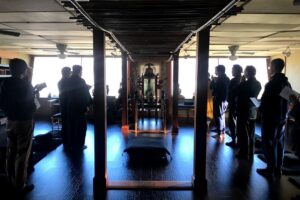
Generally, most Zen centers, temples and monasteries follow fairly strict rules, written or unwritten, about who is given any permission to speak about Zen to members and the public.
Usually, only the guiding teacher and her/his formal students are expected to address the expression of Zen understanding of buddhadharma, and under rather highly controlled circumstances. This is called “permission to speak.”
“Permission to teach” is accorded only to fully transmitted Zen priests, commonly known as “brown robes.” Black robes, novice priests, may speak but only under supervision of their teacher, and Disciples (rakusu) are also sometimes allowed to do so as a part of their training, again under supervision and in a closely watched and structured environment.
We have historically been rather liberal about this issue, even allowing non-Disciples such as members to give a talk about their experience, why they practice Zen, the twelve-step program, and such topics of expertise and interest as theories of physics and their philosophical relationship to Zen.
Seniority still means something in Zen, even if that is somewhat counter-cultural in our youth-worshipping, self-regarding society.
zenkai taiun michael elliston, roshi
Under Matsuoka Roshi, it was rare that he would invite anyone else to speak. I was regularly invited to accompany him on public speaking engagements, as he liked the way I answered people’s questions. He had guest teachers speak at the temple upon occasion, but they were exclusively other Zen priests. He presented me as an example to the other Disciples when I would visit Long Beach, but when I suggested that I answer any questions they might have, he said, with the finality that only Sensei could muster, “Questions and answers unimportant!” And of course, I agreed.
As a training function, I began asking Disciples to talk occasionally during the 80’s. When they asked what to talk about, I suggested the Heart Sutra, or any part thereof. This seemed to work well at the time.
But as time moved on, it seemed that some of my students enjoyed sharing their understanding of Zen more than they enjoyed listening to mine, and would tend to appear only when they were on schedule to speak. It also became apparent that some were developing their own faction or following within the Sangha, which made others feel that they were left out of the in-group cliques. I even had a complaint or two from some senior Sangha members that I was allowing my students to do too much of the teaching. A few expressed an unseemly eagerness to have “their own Disciples.” (My students are not “my disciples”; we are all Disciples of Buddhism.)
So I began scaling back that approach, and witnessed what I registered as some resistance, disgruntlement, perhaps even resentment over the change. The same issue was writ large at certain affiliates, where the local group depended upon the presence of the practice leader(s), by definition Disciples, not yet priests, which led to some conflicts and their resolution, not always to the satisfaction of all parties.
The advent of online technology, which has allowed me to manifest a presence within affiliates has mitigated the problem somewhat, proving that one can be in two places at once, although that miracle does not miraculously solve all problems.
Now we have a situation in which if a person is asked or volunteers to cover a sitting session such as an evening or part of a retreat, it seems that they assume that they are called upon to speak, lead a discussion, or at least conduct a reading circle. This is the unexpected and unintended consequence of a training technique gone awry. And it should be neither the expectation of the Disciple nor the attendees.
In Chicago, we offered zazen at 10 am and 2 pm on Sundays, and on Tuesday and Thursday evenings. That was pretty much the entire schedule other than holidays and special events such as the public talks. I was never asked to speak to the members, let alone give a public talk. I had to do those things once I moved to Atlanta and Sensei moved to Long Beach, in 1970. When Sensei came to town, he did all the speaking, which seemed natural to me.
When I visit affiliates, that is usually the case, but occasionally the practice leader there would sometimes lead the presentation, rather than deferring to myself. This is not the Zen way. Seniority still means something in Zen, even if that is somewhat counter-cultural in our youth-worshipping, self-regarding society.
My opinion is that most of our meditation sessions should be just that, zazen and little else. It is enough that we open the doors and offer a simple but dependable opportunity for members to sit for a couple of periods or a whole day or week, as we do in the morning sessions, with a brief closing ceremony. It may be more fun to talk and discuss, but this is kaffe-klatsch Buddhism, and they can find that in many places. And it has the pitfalls of distorting the essence of Zen practice as well as the training of the leader du jour. It has led to anomalies such as one Disciple regularly taking the group out for beer and pizza after each session, late into the night. This is not the Zen way, though it may make one more popular amongst the hoi polloi.
So let’s consider most evening or morning sessions to be “Just Sit.” If attendees are interested in discussion, they are invited for Sunday Dharma Dialog and structured weekly Skype sessions, return visits to Wednesday Newcomer Workshop, and to engage in personal practice discussion and dokusan with myself. That’s ’nuff said.









